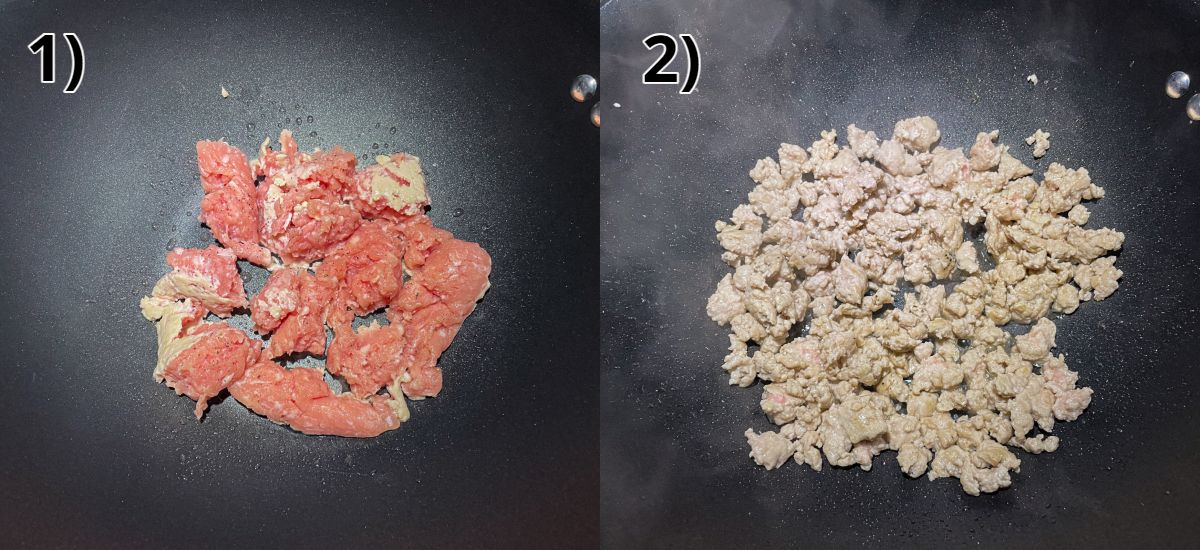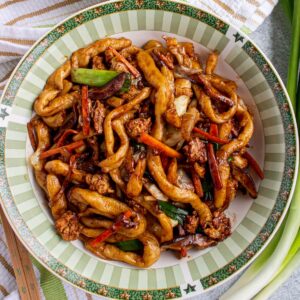Yaki Udon is a super easy and versatile stir-fried noodle dish that is perfect for weeknights. Customize it with your favorite proteins, use up leftover veggies in the fridge, and create simple but tasty, craveable noodles in 20 minutes.

Yaki udon (焼きうどん, meaning "fried udon") is a Japanese stir-fried noodle dish featuring thick, slurpable udon noodles, a colorful array of vegetables, and a soy sauce-based stir-fry sauce.
Yaki udon is similar to yakisoba, however the former uses thick, chewy udon noodles, while the latter uses thinner ramen-style wheat noodles. It was invented just after World War II when food was scarce. A Japanese restaurant owner made yakisoba with udon noodles because the correct noodles were unavailable.
With that in mind, there is no single recipe for yaki udon, but rather a basic framework that can easily be tweaked and adjusted based on what you like or have on hand.
Ingredient notes

- Udon Noodles: The udon noodles in these photos are my homemade udon noodles (they're cut by hand which is why they look more rustic and imperfect), but you can of course use store-bought noodles here. If using store-bought udon, the preferable options are frozen or parboiled (precooked) fresh noodles (ideally "Sanuki-style" udon noodles). You'll find these in the refrigerated or frozen sections of Asian markets. Because they're already cooked, they only require a minute or so in boiling water to refresh them before enjoying! Dry noodles can work but are less preferable, as they're flat and less chewy.
- Protein: Use whatever protein you want or have on hand for these easy and versatile yaki udon noodles. Some options include thinly sliced chicken, beef or pork; ground chicken, turkey, beef or pork; peeled and deveined medium shrimp; mixed seafood; or sliced or cubed tofu. You could also skip the protein altogether and just add more veggies.
- Vegetables: I use sliced onion, shredded/sliced cabbage, julienned carrots, sliced shiitake mushrooms, and scallions as the vegetables in my yaki udon. You can customize the recipe to use other veggies you have on hand. Consider sugar snap peas, bok choy, bamboo shoots, broccoli, or zucchini as other options.
- Dark Soy Sauce: You can substitute regular soy sauce if you don’t have dark soy sauce, but the color of the finished noodles won’t be as dark, and the flavor will be a bit different.
- Oyster Sauce: Oyster sauce is a great stir-fry base. It's thick and very umami. If you're vegetarian, get a vegetarian oyster sauce which uses mushrooms instead of oyster extractives for the flavoring.
- Mirin: Mirin is a Japanese rice wine which is common in Japanese cooking. It's similar to sake but with a lower alcohol content and higher sugar content. In a pinch, you could use another white cooking wine or sake in this recipe if you don't have mirin.

How to make it
Combine oyster sauce, dark soy sauce, mirin, and light brown sugar in a small bowl to create the flavoring sauce. Set aside.
Bring a pot of water to a boil and add the udon noodles. Even if they come frozen, they are pre-cooked so it only takes 1 minute usually to just blanch them to refresh them. Don’t overcook or they will get mushy. Drain and rinse them with cold water.
Heat oil in a large wok or skillet (preferably non-stick) over medium to medium-high heat. Add your choice of protein to the pan and season with salt and pepper (PHOTO 1). Stir-fry until the protein is just cooked through. The timing will depend on your choice of protein. If using ground meat, break it up with the side of a wooden spoon as you stir-fry (PHOTO 2).

Add the sliced onion and stir-fry for another couple minutes until it starts to soften (PHOTOS 3-4).

Then add the cabbage, carrot, mushrooms, and scallions and continue to stir-fry for 2 to 3 more minutes or until the vegetables wilt and soften (PHOTOS 5-6).

Add the noodles and the sauce.

Toss the mixture to ensure everything is evenly coated in sauce and that the noodles are heated through. Taste and adjust seasoning if needed. Serve immediately.
Please scroll to the bottom of the post for the full recipe (in a printable recipe card) including ingredient amounts and detailed instructions.

Expert tips
Store leftover yaki udon in an airtight container in the refrigerator for up to 3 days.
Although this recipe makes 2 generous portions, there is enough yaki udon for 3 slightly smaller (average) portions if you want to share between 3 people or have some leftovers.
While a wooden spoon is a great tool for the early steps of making this recipe, especially if you use ground meat you need to break up, I recommend using silicone tongs once you add the noodles. It's much easier to mix and also to serve the noodles once you're finished.
Use a wok (here's the nonstick wok I use in these photos) or large nonstick skillet for this recipe. You want to have a lot of surface area and be able to heat the pan quickly and efficiently for a the best stir-fry results.
Just like with any stir-fry recipe, yaki udon cooks very quickly. Make sure you have all of your ingredients prepped and ready before you start cooking. I usually line them up in small bowls next to the stovetop in the order I need to add them.

Other recipes you may like
- Homemade Udon Noodles
- Beef Teriyaki Udon Noodles
- Kare Udon (Japanese Curry Udon Soup)
- Mie Goreng (Indonesian Stir-Fried Noodles)
- Garlic Noodles
- Ants Climbing a Tree
- Singapore Noodles (Singapore Mei Fun)
- Ram-Don from Parasite (Jjapaguri with Steak)
- Japchae (Korean Sweet Potato Noodles with Meat and Vegetables)
- Pork Lo Mein
Tried this recipe? Please leave a star ⭐️⭐️⭐️⭐️⭐️ rating in the recipe card below and/or a review in the comments section further down the page. You can also follow me on social media on Facebook, Instagram, and Pinterest!

Yaki Udon (Japanese Stir-Fried Udon Noodles)
Ingredients
Sauce:
- 2 tablespoons oyster sauce
- 1 tablespoon dark soy sauce
- 1 tablespoon mirin
- 2 teaspoons packed light brown sugar
Noodles:
- 1.1 pounds (500 grams) udon noodles frozen or parboiled fresh (about 300 grams uncooked homemade udon noodles)
- 1 tablespoon neutral oil such as vegetable, avocado, sunflower and safflower oil
- 8 ounces (225 grams) protein of your choice (such as thinly sliced chicken, beef or pork; ground chicken, turkey, beef or pork; peeled and deveined medium shrimp; mixed seafood; sliced or cubed tofu; or substitute with additional vegetables)
- Kosher salt and freshly ground black pepper
- 1 small onion or ½ medium onion peeled, halved, and thinly sliced
- 1 cup (65 grams) shredded green or napa cabbage
- ½ cup (60 grams) julienned carrot (2-by-⅛-inch matchsticks)
- 4 fresh shiitake mushrooms stemmed and thinly sliced
- 2 scallions cut into 2-inch long pieces
Instructions
- Combine sauce ingredients in a small bowl and set aside.
- Bring a pot of water to a boil and add the udon noodles. Even if they come frozen, they are pre-cooked so it only takes 1 minute usually to just blanch them to refresh them. Don’t overcook or they will get mushy (they will continue to cook when you stir-fry them). Drain and rinse them with cold water.
- Heat oil in a large wok or skillet (preferably non-stick) over medium to medium-high heat. Add your choice of protein to the pan and season with salt and pepper. Stir-fry until the protein is just cooked through (the timing will depend on your choice of protein; if using ground meat, break it up with the side of a wooden spoon as you stir-fry).
- Add the sliced onion and stir-fry for another couple minutes until it starts to soften. Then add the cabbage, carrot, mushrooms, and scallions and continue to stir-fry for 2 to 3 more minutes or until the vegetables wilt and soften.
- Add the noodles and the sauce, tossing the mixture to ensure everything is evenly coated in sauce and that the noodles are heated through. Taste and adjust seasoning if needed. Serve immediately.
Notes
- The nutrition information above is based on 2 servings and was calculated using ground pork as the protein. Although this recipe makes 2 generous portions, there is enough yaki udon for 3 slightly smaller (average) portions if you want to share between 3 people or have some leftovers.
- I used my homemade udon noodles in this post (they're cut by hand which is why they look more rustic and imperfect), but you can of course use store-bought noodles here. If using store-bought udon, the preferable options are frozen or parboiled (precooked) fresh noodles (ideally "Sanuki-style" udon noodles). You'll find these in the refrigerated or frozen sections of Asian markets. Because they're already cooked, they only require a minute or so in boiling water to refresh them before enjoying! Dry noodles can work but are less preferable, as they're flat and less chewy.
- You can customize the recipe to use other veggies you have on hand. Consider sugar snap peas, bok choy, bamboo shoots, broccoli, or zucchini as other options.
- Just like with any stir-fry recipe, the cooking process moves very quickly. Make sure you have all of your ingredients prepped and ready before you start cooking. I usually line them up in small bowls next to the stovetop in the order I need to add them.
Nutrition
*All nutritional information is based on third-party calculations and should be considered estimates. Actual nutritional content will vary with brands used, measuring methods, portion sizes and more.*






Diana says
I loved this recipe! The ingredients were easy to find, and it had great flavor. It was easy to add in different veggies, and we used tofu as our protein. The whole thing came together in about 20 minutes, including prep. My young children really enjoyed this, and my daughter even gave the recipe a, “20 out of 10!” We will definitely add this into the meal rotation.